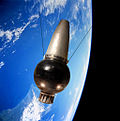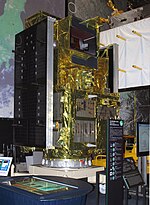 | launched shortly after TSUBAME's first design concept was published in 2004. TSUBAME was launched with four other satellites from Yasny Cosmodrome on... 11 KB (1,254 words) - 19:50, 28 March 2024 |
Super Low Altitude Test Satellite (SLATS) or Tsubame was a JAXA satellite intended to demonstrate operations in very low Earth orbit (VLEO, below 200 km)... 6 KB (457 words) - 19:33, 11 September 2023 |
Tsubame (燕, tsubame) is the Japanese name for the barn swallow. Tsubame may also refer to: Tsubame, Niigata, a city in Japan Tsubame (train), the name... 1 KB (183 words) - 16:07, 10 May 2023 |
Yuri, also known as Broadcasting Satellite or BS, was a series of Japanese direct broadcast satellites. The first satellite of this series, called BSE or... 6 KB (321 words) - 01:32, 27 April 2024 |
 | Ōsumi (or Ohsumi, おおすみ) was the first Japanese satellite put into orbit. It was launched on February 11, 1970 at 04:25 UTC with a Lambda 4S-5 rocket from... 5 KB (186 words) - 20:52, 5 December 2023 |
Ajisai (redirect from Ajisai (satellite)) Japanese satellite sponsored by NASDA, launched in 1986 on the maiden flight of the H-I rocket. It is also known as the Experimental Geodetic Satellite (EGS)... 8 KB (782 words) - 15:32, 4 April 2024 |
also known as ASTRO-A before launch, was a Japanese X-ray astronomy satellite. It was developed by the Institute of Space and Astronautical Science... 6 KB (252 words) - 20:19, 30 December 2021 |
 | height 280 km, apogee height 686 km, inclination 98.3 degrees. Then the satellite maneuvered to the quasi-circular Sun-synchronous orbit over the day/night... 15 KB (874 words) - 17:23, 26 March 2024 |
 | Hiroshi Sakurazaka, author Akihiro Murayama, mixed martial artist TSUBAME (satellite) Number of Graduate Students. Tokyo University of Science. Retrieved... 23 KB (1,893 words) - 15:37, 12 March 2024 |
 | Advanced Land Observing Satellite (ALOS), also called Daichi (a Japanese word meaning "land"), was a 3810 kg Japanese satellite launched in 2006. After... 8 KB (485 words) - 11:34, 26 February 2024 |
ASTRO-C, renamed Ginga (Japanese for 'galaxy'), was an X-ray astronomy satellite launched from the Kagoshima Space Center on 5 February 1987 using M-3SII... 9 KB (191 words) - 05:44, 27 August 2023 |
The Innovative Satellite Technology Demonstration Program is a series of spacecraft missions for testing technology and ideas put forward by universities... 23 KB (2,117 words) - 17:16, 10 March 2024 |
Cosmic Radiation Satellite (CORSA, also CORSA-A) was a Japanese space telescope. It was supposed to be Japan's first X-ray astronomy satellite but was lost... 952 bytes (78 words) - 23:51, 24 April 2024 |
SOLAR-C (category Satellites of Japan) "High-sensitivity Solar Ultraviolet Spectroscopic Satellite") is a planned Sun-observing satellite being developed by the Japan Aerospace Exploration... 5 KB (338 words) - 16:21, 15 March 2024 |
Information Gathering Satellite (情報収集衛星, Jōhō Shūshū Eisei) are the satellites of the Japanese spy satellite program. It was started as a response to the... 13 KB (912 words) - 21:03, 25 February 2024 |
November 2021 by an Epsilon launch vehicle as part of the Innovative Satellite Technology Demonstration Program-2 mission. The key technology to be tested... 5 KB (397 words) - 03:08, 6 February 2024 |
 | AKARI (ASTRO-F) was an infrared astronomy satellite developed by Japan Aerospace Exploration Agency, in cooperation with institutes of Europe and Korea... 13 KB (1,012 words) - 01:34, 20 April 2024 |
 | Multifunctional Transport Satellites (MTSAT) were a series of weather and aviation control satellites. They are replaced by Himawari 8 on 7 July 2015... 6 KB (617 words) - 14:59, 22 December 2023 |
 | The Advanced Satellite for Cosmology and Astrophysics (ASCA, formerly named ASTRO-D) was the fourth cosmic X-ray astronomy mission by JAXA, and the second... 9 KB (745 words) - 22:26, 25 April 2022 |
 | HALCA (redirect from Haruka (satellite)) or just Haruka (はるか) was a Japanese 8 meter diameter radio telescope satellite which was used for Very Long Baseline Interferometry (VLBI). It was the... 8 KB (603 words) - 01:15, 2 January 2024 |
 | ADEOS II (redirect from ADEOS II (satellite)) ADEOS II (Advanced Earth Observing Satellite 2) was an Earth observation satellite (EOS) launched by NASDA, with contributions from NASA and CNES, in... 16 KB (1,560 words) - 05:45, 1 May 2024 |
the end of the series, only Hibari and Tsubame fuse with their Divas; Hibari beginning in episode 17 and Tsubame during episode 21. In the movie, all five... 33 KB (3,508 words) - 05:58, 24 December 2023 |
Suisen (redirect from Fukui Prefectural Satellite) Suisen (すいせん), also known as Fukui Prefectural Satellite is an Earth observation satellite of the Fukui Satellite Technology & Research Association (FSTRA)... 3 KB (263 words) - 19:34, 20 January 2024 |
The Nano-Japan Astrometry Satellite Mission for Infrared Exploration (Nano-JASMINE) is an astrometric microsatellite developed by the National Astronomical... 10 KB (913 words) - 20:34, 24 September 2023 |






